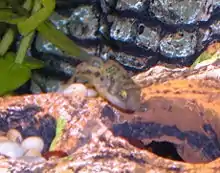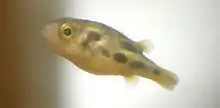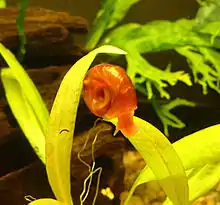Dwarf pufferfish
The dwarf pufferfish (Carinotetraodon travancoricus, originally Tetraodon (Monotretus) travancoricus)[1], also known as the Malabar pufferfish (leading to easy confusion with the related C. imitator), pea pufferfish or pygmy pufferfish, is a small, freshwater pufferfish endemic to Kerala and southern Karnataka in Southwest India. They are threatened by overfishing for the aquarium trade[3] and by habitat loss.[1]
| Carinotetraodon travancoricus | |
|---|---|
 | |
| Scientific classification | |
| Kingdom: | Animalia |
| Phylum: | Chordata |
| Class: | Actinopterygii |
| Order: | Tetraodontiformes |
| Family: | Tetraodontidae |
| Genus: | Carinotetraodon |
| Species: | C. travancoricus |
| Binomial name | |
| Carinotetraodon travancoricus | |
The maximum documented size is 3.5 cm (1.4 in),[4] making them one of the smallest pufferfish in the world.[5] Although closely related to marine pufferfish, they are not found in salt water, and reports to the contrary are based on misidentification.[6]
Distribution and status
Dwarf pufferfish are a potamodromous species[7][8] endemic to rivers, lakes, and estuaries in Kerala and southern Karnataka in the Western Ghats of Peninsular India.[1][9] It is reported from 13 rivers in Kerala, inhabiting heavily vegetated waters,[3] including Pamba River,[2] Chalakudy River,[10] Periyar, Kechery,[11] Muvattupuzha,[12], Vembanad, Meenachil River, and Cherthala,[13] and reported as rare in Bharathapuzha[14] and the Nilgiri Biosphere Reserve.[15] The species was also reported from inundated brickyards in Puthukkad,[11] as well as ditches, ponds, irrigation channels, and artifical tanks or abandoned water bodies in paddy fields. The large range of their distribution and their appearances in small, secluded bodies of water is likely mediated in part by piscivorous birds unintentionally dispersing individuals.[16]
Several researchers have considered the species to be endangered,[17][18][10] though with no rationale provided. The dwarf pufferfish is officially classified as vulnerable on the IUCN Red List due to declining populations because of damming, indiscriminate deforestation for agriculture, pollution from waste water, and, primarily, overharvesting for the aquarium trade.[1][3] In 2010, some researchers estimated that the population would decline by 30–40% from 2005 to 2015,[1][17] while others estimated it had already declined by the same amount between 2005 and 2010.[19]
Description

Both sexes are primarily greenish-yellow with dark green to black iridescent patches on the flanks and dorsal surface, and light yellow or white and typically without patches on the ventral surface. Patterns and colouration varies considerably between individuals. Their pectoral fins are short, slightly emarginate, and fan-shaped. The dorsal and anal fins are situated opposite each other toward the posterior of the fish, both short and round, while the caudal fin is larger and truncate.[2] As with other members of the genus, sexual dimorphism is apparent in mature fish, with males being more brightly coloured than females.[5] Males can also have a dark stripe down the center of their pale belly and iridescent "eye wrinkle" patterns that females do not have. Females are more rounded, tend to be a bit larger than males, and may or may not show more smallish spots between their larger dark markings.
Sexing of juveniles is impossible because these fish "choose" their sex as they mature. Once one pufferfish begins becoming a male he excretes hormones to prevent the other puffers from becoming male. However, if two fish start to mature into males at the same time one will become the dominant male. There is also a dorsal crest, but it lacks special colouration when not erect. Both crests are displayed during courtship while the male circles the female. They also will have more yellow colouration.
Diet and behavior
Dwarf pufferfish are a slow-swimming,[16] demersal species.[7][8] Their diet in the wild mainly consists of small animals such as cladocera, rotifers, copepods and insects. Sand and detritus, presumably ingested by mistake when feeding on small, bottom-dwelling animals, has also been found in the gut of dwarf pufferfish.
Though many freshwater pufferfish accumulate saxitoxin in their skin due to their consumption of specific cyanobacteria present on or in their food sources, there is little or no reliable evidence to suggest dwarf pufferfish also contains this neurotoxin.[20]

In captivity, the dwarf pufferfish will eat small snails such as ramshorn snails, bladder snails, and Malaysian trumpet snails, as well as some frozen foods like bloodworms, and brine shrimp, which can also be fed live. Pufferfish like to have a varied diet and it's important to feed different foods when keeping dwarf puffer fish in captivity. Other members of the genus feed on zooplankton and various benthic crustaceans and molluscs.[21] Food items of specimens maintained in aquaria appears to be similar.[5] Dwarf pufferfish are commonly associated with plants in the genus Cabomba, and the presence of these plants has been shown to reduce mortality among captive specimens.[3]
Unlike many other pufferfish species that are primarily solitary, dwarf pufferfish are found in large shoals, occasionally consisting of hundreds of individuals, mainly during summer months (January to May) and very rarely during the rainy season.[11] Due to their shoaling nature, aquarium hobbyists have found the fish will exhibit aggression between conspecifics when kept in groups of fewer than six individuals, or when there is more than one male for every two females.
Reproduction
Captive breeding of pufferfish is somewhat difficult,[22] and capture for the pet trade threatens the species in the wild.[1]
Dwarf pufferfish eggs are fertilized externally. In the aquarium, dwarf pufferfish are often plant-spawners, laying eggs in plants (including java moss in aquariums) or on the substrate hidden within plants. Eggs have been seen to hatch after five days at 27 °C (81 °F), with fry initially being fed on infusoria, then brine shrimp when they are a week old, and finally regular-sized food.[23] Dwarf pufferfish do not guard their eggs or fry, and breeders do not keep the adults and the fry together.[5][24]
Association with humans
When first described in 1941, K. Nair noted that dwarf pufferfish were a favourite of children, who would catch and use the fish as playthings.[2] They are regarded as "frog tadpoles" by local fisherman[11] and otherwise given little regard. They are of no interest to fisheries[25], are not a food fish, and are only valued as ornamental fish in aquaria.[26][1]
Captivity and aquaria
Dwarf pufferfish have become popular as aquarium fish thanks to their attractive colours, small size, and relative ease of maintenance.[5][24] The dwarf pufferfish is also one of the few aquarium fish to regularly eat small, live snails, so it is used in controlling snail populations. Dwarf pufferfish sold in stores are most likely to have been wild-caught juveniles, as opposed to commercially-farmed or captive-bred individuals.
References
- Dahanukar, N. (2011). "Carinotetraodon travancoricus". IUCN Red List of Threatened Species. 2011: e.T166591A174788004. doi:10.2305/IUCN.UK.2011-1.RLTS.T166591A174788004.en. Retrieved 4 May 2022.
- Hora, S.L.; Nair, K.K. (1941). "New records of freshwater fish from Travancore". Records of the Indian Museum. 43: 387–393. Retrieved 4 May 2022.
- Anupama, K.M.; Harikrishnan, M. (2015). "Improved survival of Malabar puffer fish, Carinotetraodon travancoricus (Hora and Nair, 1941) in planted aquaria". International Journal of Environmental Sciences. 6 (1): 138–144. doi:10.6088/ijes.6016. ISSN 0976-4402. Retrieved 5 May 2022.
- Froese, Rainer; Pauly, Daniel (eds.) (2017). "Carinotetraodon travancoricus" in FishBase. January 2017 version.
- Klaus Ebert (2001). The Puffers of Fresh and Brackish Water. Aqualog. pp. 19, 46–49. ISBN 3-931702-60-X.
- Schäfer F. Brackish Water Fishes, p 34. Aqualog 2005, ISBN 3-936027-82-X
- Froese, Rainer; Pauly, Daniel (eds.) (2021). "Carinotetraodon travancoricusus" in FishBase. September 2021 version.
- "Carinotetraodon travancoricus (Hora & Nair, 1941) Malabar pufferfish". FishBase. FishBase. Retrieved 5 May 2022.
- Devi, K.R.; Indra, T.J.; Raghunathan, M.B. (2000). "On a report of Tetradon (Monotretus) travancoricus, from south Kanara, Karnataka, India". Journal of the Bombay Natural History Society. 97 (3): 441–443. Retrieved 4 May 2022.
- Raghavan, R.; Prasad, G.; Ali, A.P.H.; Pereira, B. (2008). "Fish fauna of Chalakudy River, part of Western Ghats biodiversity hotspot, Kerala, India: patterns of distribution, threats and conservation needs". Biodiversity and Conservation. 17 (13): 3119–3131.
- Biju, C.R., C.R.; Thomas, R.K.; Ajithkumar, C.R.; George, M.J. (1999). "Occurrence of Tetraodon travancoricus (Hora and Nair) in the Chalakudy, Periyar and Kechery rivers, Kerala". Journal of the Bombay Natural History Society. 96 (1): 161. Retrieved 4 May 2022.
- Beevi, K.S. Jameela; Ramachandran, A. (26 September 2009). "Checklist of freshwater fishes collected from Ernakulam District, Kerala, India" (PDF). Journal of Threatened Taxa. 1 (9): 493–494. doi:10.11609/JoTT.o1559.493-4. Retrieved 4 May 2022.
- Devi, K.R.; Indra, T.J.; Emiliyamma, K. J. (1996). "On the Fish Collections from Kerala, Deposited in Southern Regional Station, Zoological Survey of India by NRM Stockholm" (PDF). Records of Zoological Survey of India. 95: 3–4. Retrieved 4 May 2022.
- Bijukumar, A.; Philip, Siby; Ali, Anvar; Sushama, S.; Raghavan, Rajeev (26 November 2013). "Fishes of River Bharathapuzha, Kerala, India: diversity, distribution, threats and conservation". Journal of Threatened Taxa. 5 (15): 4979–4993. doi:10.11609/JoTT.o3640.4979-93.
- Easa, P.S.; Shaji, C.P. (1997). "Freshwater fish diversity in Kera a part of the Nilgiri Biosphere Reserve". Current Science. 73 (2): 180–182.
- Gopi, K.C.; Radhakrishnan, C. (2007). "Waterbird-Mediated Chance-Dispersal of Fishes: A Natural Process of Affecting Range of Distribution and Biogeography of Fishes" (PDF). Records of the Zoological Survey of India. 108 (1): 19–31. Retrieved 6 May 2022.
- Dahanukar, Neelesh; Raut, Rupesh; Bhat, Anuradha (22 December 2003). "Distribution, endemism and threat status of freshwater fishes in the Western Ghats of India" (PDF). Journal of Biogeography. 31: 123–136.
- Thomas, K.; George, M.; Biju, C. (April 2002). "Freshwater Fishes of Southern Kerala with Notes on the Distribution of Endemic and Endangered Species". Journal of the Bombay Natural History Society. 99 (1): 47–53. Retrieved 4 May 2022.
- Kurup, B.M.; Manojkumar, T.G. (2010). "Central Marine Fisheries Research Institute". Indian Journal of Fisheries. India: Central Marine Fisheries Research Institute. 57 (1): 81–85. ISSN 0970-6011.
- Hellweg, Mike (March 2007). "The Dwarf Puffer: A Pleasant Little Surprise". TFH Magazine. Retrieved 5 May 2022.
- Froese, R.; D. Pauly (eds.). "Food Items Reported for Carinotetraodon lorteti". FishBase. Retrieved 7 March 2007.
- Breeding – Dwarf Puffer (Nov.-Dec. 2005), Frank Stopper
- Ralph, Chris (2003). Practical Fishkeeping: Pufferfish, p. 61. ISBN 1-86054-233-6
- Wenzel, R. (2004). Carinotetraodon travancoricus. Die Aquarien- und Terrarienzeitschrift 1/2004:36-37
- Talwar, P. K.; Jhingran, A.G. (1991). Inland fishes of India and adjacent countries. New Delhi: Oxford & IBH Pub. Co. ISBN 9788120406391.
- Ponniah, A.G.; Gopalakrishnan, A. (2000). Endemic fish diversity of Western Ghats (PDF). Lucknow, India: National Bureau of Fish Genetic Resources. pp. 13–32. ISBN 81-901014-2-0. Retrieved 5 May 2022.
External links
| Wikimedia Commons has media related to Carinotetraodon travancoricus. |
